Helena P. Schrader's Blog, page 37
February 2, 2018
On the Crusader Trail in the County of Tripoli
A Guest Post from Michelle FoltzMichelle recently returned from Lebanon, where she visited several sites from the crusader era. She agreed to share her findings with readers of my blog.
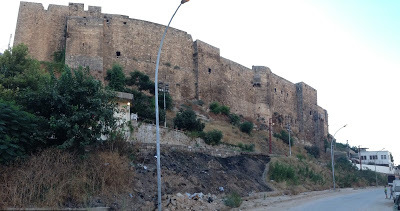 Citadel of Count Raymond of Saint Gilles (copyright M.Foltz)
Citadel of Count Raymond of Saint Gilles (copyright M.Foltz) Tripoli
The Citadel of Count Raymond of Saint Gilles (Qalʿat Sanjīl ) deserves top billing of the Crusader sites in the city of Tripoli if only for its powerful, physical presence. Historically it was the site of important military and administrative functions for every conqueror and defender of the area—from the southern French Crusaders in the early 12th C to the Ottomans in the 20th. The Citadel’s function as a defensive structure was destroyed during the Mamluk conquest in the late 13th century and the ruins left unoccupied for the next 20 years before it was rehabilitated and expanded. Despite this history, the façade of the Citadel has the external appearance and majestic proportions to kindle the desire of any pilgrim on the ‘Crusader Trail’ to claim it as wholly crusader.
Today it is difficult to identify the exact demarcations of the original structure as old stones have been recycled in successive rebuildings. Medieval ashlar of the earliest construction could have been refashioned and used for the top level of the parapets centuries after it was originally quarried, laid, and torn down. One notices rocks of different sizes and shapes to those on either side or in adjacent courses or as arches filled-in or half obliterated. This is most noticeable at the corners and interfaces of walls, typifying the various styles and changing functions over the centuries. However, experts of medieval architecture write that the foundations show distinctive features of southern French or Provençal heritage, the home of San Gilles and his followers, the original, Crusader builders.
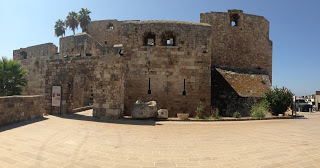 Tripoli - Northern Gate to the Citadel
Tripoli - Northern Gate to the Citadel (copyright M.Foltz)
Most of the extant interior walls and terraces were built during Ottoman timesfor military and administrative functions. The prison, barracks, store rooms, and stables are well identified in the posted explanations. The most identifiable internal crusader structure is the rectangular outline of the Church of the Holy Sepulcher of Mont-Pilgrim that the San Gilles rulers built over a pre-existing Shia’a saint’s mausoleum. This Muslim holy place was said to remind Count Raymond of the Church of the Holy Sepulcher in Jerusalem, the liberation of which had been the primary focus of the First Crusade. A partially intact engaged column and pier that formed one of the arches that supported the missing barrel vault of the Romanesque church is the only distinctive Christian remains in the interior.
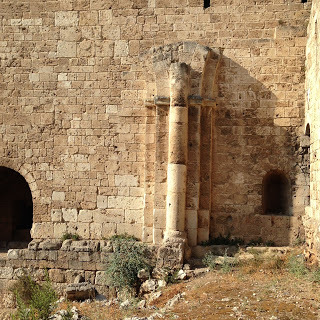 Crusader Column in the Chapel of the Citadel, Tripoli
Crusader Column in the Chapel of the Citadel, Tripoli (copyright M.Foltz)
Two museums are housed within the Citadel. One concerns the history of the Citadel itself. The other, in the long, gracefully vaulted Ottoman barracks, contains historical objects and information concerning a number of archeological sites in northern Lebanon. The official ticket seller/guardian must be specifically asked to open this latter museum and seemed to have little tolerance for an extended visit. Both are well worth a thorough perusal.
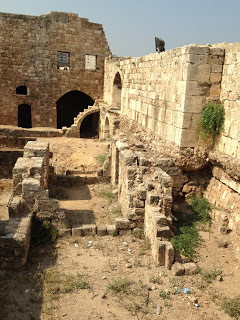 Inside the Citadel in Tripoli (Copyright M. Foltz)
Inside the Citadel in Tripoli (Copyright M. Foltz) The Citadel sits in the center of modern Tripoli overlooking the present day souks and the city west to the Mediterranean Sea. In 1102 and until the early 20th C the Citadel lay well beyond the city’s boundaries, whose center was the port, Al-Mina, on the peninsula. Before capture by the crusaders, the 11th C city was famous as a center for culture and learning and was ruled by the Shia’a Banu Ammar family who held close ties with the Fatimids in Egypt.
Count Raymond built the Citadel three kms from the coastal city walls, on a ridge near a bridge on the Abu Ali River and called it Mount Pilgrim, Mons Peregrinus. From this position he began besieging the city while controlling access to the town from Damascus, Homs, and Aleppo. Despite this advantageous position, it took the combined Crusader armies, seven years, and the help of Provençal and Genoese fleets before the city was secured and the County of Tripoli established as the fourth Crusader state.* The counts ruled from the city, leaving the Citadel as an outer defensive bastion. In the mid 12th C. it was given to the Hospitaller knights who used it, along with the great fortress of Krac des Chevaliers and a surrounding network of smaller forts, to solidify their growing political, economic, and defensive role in the County.
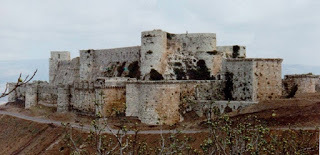 Krak des Chevaliers (copyright HSchrader)
Krak des Chevaliers (copyright HSchrader) Standing on the Citadel’s ramparts and looking west to the sea individual domes, minarets, and khans are identifiable from the mass of structures below. A bit of imagination can convert the area between the souks and the port of Al-Mina into the extensive orange and olive groves that once dominated this open space before it was filled-in during 20th century expansion.
To a ‘western eye’, one of the most distinctive buildings is the square plan Romanesque minaret of the Grand Mosque that would not be out of place at the summit of a Lombard hill town. It was once the bell tower for the medieval Church of St. Mary. History is filled with conquerors destroying or desecrating the religious shrines of their enemies. History is also filled with conquerors re-purposing or incorporating the religious structures of their enemies into a different context—religious or other—involving a major refashioning to alter the existing orientation. The minaret of Tripoli’s Grand Mosque is at the extreme end of accepting the whole cloth of a religious structure without alteration. Nothing hides its Frankish origins; only a simple crescent filial converts its religion, but not its function.
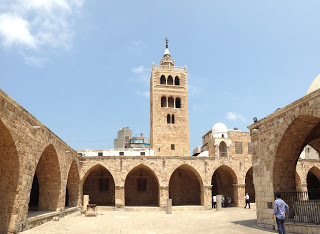 Tripoli Grand Mosque with Minaret like an Italian Church Bell Tower (copyright M.Foltz)
Tripoli Grand Mosque with Minaret like an Italian Church Bell Tower (copyright M.Foltz) The site of Tripoli’s souks were once the center of the commercial and residential city that grew up around the Citadel after the Mamluk conquest. Before that, it was the small crusader village of Mount Pilgrim. The present day souks are primarily Mamluk in layout with Ottoman layers and very few Crusader remains. The Ezzedine Hammam was once a medieval church, and it was still possible to decipher the Christian iconography of lamb and scallop shell at its entrance. The columns gracing the khan of the tailors, Khan al-Khayyatin, have all the appearance and orientation to have once graced a Byzantine chapel. Perhaps the covered Souk al-Haraj, with its evocative columns, had a function in the 12th C medieval village and before that a Roman temple? Little is specifically known or readily available to answer.
The main avenues of the souks give off numbers of narrow alleys and side streets that twist, intersect with each other, and turn, acting as defensive elements as they ascend and traverse the slope to the Citadel. Many dead end, some into small courtyards planted with fruit trees and flowers. The alleys are cool and narrow; the small, high windows with their latticed window projections, mashrabyias, allow those inside a ready view to the outside, while protecting the interior privacy. For a first trip into the souks, a good guide can lay the ground work of the past that can be fleshed out on subsequent independent visits.
Al-Mina, the present port, was the center from which the Counts of Tripoli administered their lands and the Italian commercial city-states ran their warehouses and trading emporiums. The Mamluks thoroughly destroyed this area and did not rebuild or settle in it for fear of the fleets of the Frankish rulers of Cyprus, however, it continued to be an important port connecting Europe with both Aleppo and Damascus. No Mamluk religious buildings, such as those around the Citadel and the souks, are found in Al-Mina. Even the great Ottoman era walls have been torn down or built over. Though nothing standing is Crusader, the Romanesque architecture of the 18th C Saint George’s Orthodox Cathedral shows robust Byzantine and medieval influence, while a cave below the church dates as a religious structure from long before even the 12th C.
Smar Jbeil Fortress and Town
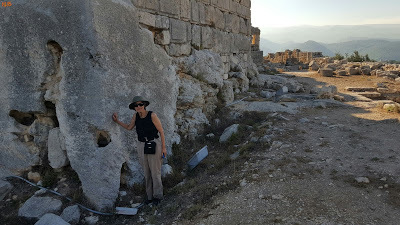 Smar Jbeil with the Author Michelle Foltz (Copyright M. Foltz)Unmentioned in guidebooks and little known to those outside the area as a Crusader site, information about Smar Jbeil is available on the Internet with various levels of accuracy. Until the Syrian army left their position in the fortress, it was not readily accessible, but since 2005 the community and the Lebanese Director General of Antiquities have worked to restore and rebuild the site.
Smar Jbeil with the Author Michelle Foltz (Copyright M. Foltz)Unmentioned in guidebooks and little known to those outside the area as a Crusader site, information about Smar Jbeil is available on the Internet with various levels of accuracy. Until the Syrian army left their position in the fortress, it was not readily accessible, but since 2005 the community and the Lebanese Director General of Antiquities have worked to restore and rebuild the site.The village and the fortress of Smar Jbeil share a history dating from at least the 3rd millennium BCE. The Phoenicians probably gave the area its name, meaning guardian or watchman over Jbeil, the important Phoenician coastal city (aka Byblos). In the 6th BCE the area came under control of the Persians, falling to the armies of Alexander in the 4th. The Romans and later the Byzantines held sway after Pompey’s conquests in the mid first century BCE. Though defensive in position and structure it is thought that the Romans used it as a governmental, administrative residence. In the 7th C CE, Mar Jean Maron, the first Maronite Patriarch, lived in the fort, turning like many of his followers to the safety of the mountains from persecutions by the Orthodox in the coastal urban areas.
The strategically lofty position of the hill top, 500 meters ASL, makes it reasonable that it was used in one form or another for defense, most likely for observation and communication purposes by all the peoples who at one time or another ruled the area. The repeated statement highlighted on the Internet, reports that a defender on the ramparts would be able to scan the Mediterranean coast from Jbeil (some sources say Jounieh) to Tripoli, some 45 kilometers in length. I could not positively identify either city on a clear morning. Still the view is gloriously impressive and knowing that most military and commercial sea travel would have rarely deviated from coastal routes, the strategic value of the fort is incontestable.
Like the crusader fortress of Qa’alat Saladin in nearby Syria and Kerak in Jordan, Smar Jbeil is built into, on, and within a great mass of bedrock, giving it an inherent strength and sense of solid defensibility. Though extremely modest in area compared to the better known medieval citadels in the Levant, it has a serene majesty of purpose for which size is of little standing. The impressive vistas to the Qadisha Valley and Bacharré to the east and northeast are as commanding as the ten km. view down to the sea.
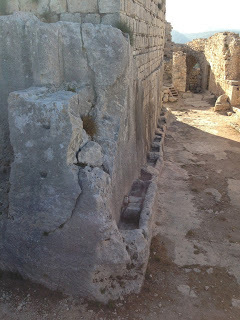 Water Troughs carved out of Bedrock at Smar Jbail. (Copyright M. Foltz)
Water Troughs carved out of Bedrock at Smar Jbail. (Copyright M. Foltz) Smar Jbeil is recorded as part of the crusader fief of Saint Montagne of the lords of Batroun who were vassals to the Counts of Tripoli. Some sources state that "the Franj" (crusaders) demolished the old castle to build a new one, calling it Chateau Fort, Strong Castle. The moat, excavated through solid rock, the enclosing wall of the fort punctuated with defensive towers, the separate, central smoothly bossed donjon, and the postern exits are all architectural elements, that along with the style and quality of the stone work, attest to crusader influence. Smar Jbeil’s strategic position along with evidence of previous fortifications and the Frankish pattern of building defensive networks of outlying fortifications give credence to the importance this site holds for crusader history.
The remains of interior structures: olive oil and/or wine presses, Roman tombs, tombs with Greek inscriptions, several hundred wells carved into the surrounding rocks, tunnels, and some indistinct bas reliefs on the northern side of the bed rock testify that the fort provided administrative and economic functions that were probably well coordinated with those in the town. Walking along the moat and around and through the defensive walls, however, there is no question this was first and foremost a significant defensive structure.
The churches of Smar Jbeil have a place in history equal to the fortress. The earliest Christian church to Mary in Lebanon (Al Sayde, Our Lady of Gifts, or Our Lady of Rescues) built in the 6th C, sits less than a hundred meters down the slope from the fortress. It stands, a poetically ruinous but spiritually compelling single nave with semicircular apse. Its south wall has been broached by the growing trunk of a thousand year old Lebanese oak whose branches arch to form a roof and whose brown leaves and acorns breeze across the floor in a moving carpet. The gently dappled en plein air ambiance enhances the tranquillity of this historical gem. The church was desecrated during the recent Syrian military occupation but has been rehabilitated by the townspeople and is being evaluated for expert restoration. It remains in service today as a venue for baptisms and weddings.
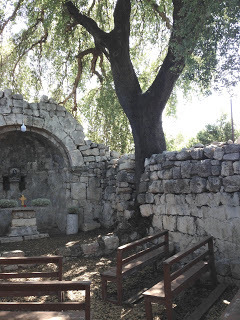 Our Lady of Gifts Chapel in Smar JbailImmediately beside the Church to Our Lady of Gifts is the main Maronite Church of Saints Bassil and Nouhra. By history an earlier church existed on the ruins of a much older Roman temple during Roman and Byzantine time. Cut rounds of recycled columns are among the ashlar courses making up the eastern wall. Major renovation by the crusaders in the 12th C was followed by various additions needed to counter wear and nature. By tradition Saint Nouhra came to Batroun from Egypt in the 4th C. When commanded to give up preaching his religion, he refused, was tortured and blinded, but miraculously continued to see, and was buried in one of the wells of the fortress. The water from this well became known for curing blindness and other diseases of sight. Nouhra is Syriac for light.
Our Lady of Gifts Chapel in Smar JbailImmediately beside the Church to Our Lady of Gifts is the main Maronite Church of Saints Bassil and Nouhra. By history an earlier church existed on the ruins of a much older Roman temple during Roman and Byzantine time. Cut rounds of recycled columns are among the ashlar courses making up the eastern wall. Major renovation by the crusaders in the 12th C was followed by various additions needed to counter wear and nature. By tradition Saint Nouhra came to Batroun from Egypt in the 4th C. When commanded to give up preaching his religion, he refused, was tortured and blinded, but miraculously continued to see, and was buried in one of the wells of the fortress. The water from this well became known for curing blindness and other diseases of sight. Nouhra is Syriac for light. The church is a square divided by four piers that support the resulting nine vaults with three alters at the east end to Bassil, Nouhra, and Mary. The walls and piers are plastered white with narrow tracings in the groins and other edges in blue and brown. Plaster molds on the piers of pairs of doves drinking from a chalice and other Christian motifs are in keeping with the uncluttered, open, clean space. The south wall, from the Byzantine era of construction, incorporates two columns that are associated with stylites—hermits or anchorites who sought God’s presence by standing for years on pillars. The western entrance and porch with 3 bays of unplastered vaulting is crusader in origin. An unusual carving graces the south portal from the porch that looks to be an unconventional dragon-fish, its symbolism unknown. The entrance on the north side of the church was redone in late Ottoman times. Draped above this entrance is a chain carved from a single block of stone, similar to the one found at the Hammam al-Jadid at the entrance to the souks in Tripoli.
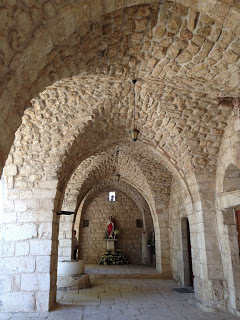
The rehabilitation of the fortress and the chapel to Our Lady in Smar Jbeil is a striking example of what a community can accomplish when it works together to care for and honor its heritage. This is in sharp contrast to the attitude in Tripoli where a perverse pride of ignorance of the town’s history seems the norm. People boasted of never having visited the Citadel. Perhaps there is too much history to sort out, or the history doesn’t fit with present nationalistic ideals.
* The other three: County of Edessa, Principality of Antioch, and Kingdom of Jerusalem
The Jerusalem Trilogy is set in the crusader period.

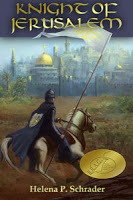
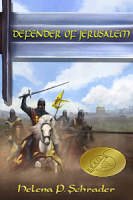
Buy now! Buy now! Buy now!
Published on February 02, 2018 05:08
January 26, 2018
"Encounter in a Seaside Tavern" - An Excerpt from "The Last Crusader Kingdom"
The Last Crusader Kingdom

"Encounter in a Tavern"An Excerpt
In the stables, John first got Lord Aimery’s palfrey tacked up and then Centurion, while [his dog] Barry kept watch at the door warily. It seemed a long time before Lord Aimery loomed in the stable door, but he had their gear, and together they tied it on the pack horse.
From the tavern came the sound of men grumbling and calling for their bills. “Closing time!” John whispered to Lord Aimery.
“They’ll all be coming out, then,” Lord Aimery drew the correct conclusion. “Hurry.”
John grabbed the lead of the pack horse and took Centurion by the bridle, while Lord Aimery took charge of his two horses. They made it out into the courtyard, but before they had a chance to mount, men spilled from the tavern into the yard.
“Mount!” Lord Aimery hissed at John, but before he could even get his foot in the stirrup one of the Greeks lunged at John, drawing a knife as he did so.
John saw the steel blade in the darkness and tried to jump aside, only to collide with the pack horse. He felt the blade hit his side and then slide over the rings of his hauberk. The man drew his arm back for a second strike as, with the clatter of hooves, Lord Aimery spurred forward, his sword raised. Most of the crowd fled to the safety of the building, but the attacker grabbed John by the throat of his hauberk with his left hand and swung him about, using John as his shield against Lord Aimery’s sword. John felt him draw back his right hand for a second stab. In his mind he registered that at this range his chain mail wouldn’t save him.
Suddenly his assailant was screaming in pain and terror as Barry sank his fangs deep into the man’s buttocks and dragged him away from John. Immediately Lord Aimery spurred past a dazed John and, leaning down from his saddle, swung his sword in a blow strong enough to nearly decapitate the would-be murderer.
As the man collapsed in a spume of his own blood, Lord Aimery turned his horse again, shouting to his still-dazed squire: “Mount!”
John turned, grabbed the near stirrup, and pulled himself up into the saddle. Lord Aimery spurred toward the exit to the stable yard with his destrier on the lead. Centurion leapt forward without awaiting any human instructions, and the pack horse followed out of habit. Barry brought up the rear at a lope, his tail in the air and his ears up -- as if he were enjoying himself for the first time since he’d acquired a new master.
 Buy Now!
Buy Now!

"Encounter in a Tavern"An Excerpt
In the stables, John first got Lord Aimery’s palfrey tacked up and then Centurion, while [his dog] Barry kept watch at the door warily. It seemed a long time before Lord Aimery loomed in the stable door, but he had their gear, and together they tied it on the pack horse.
From the tavern came the sound of men grumbling and calling for their bills. “Closing time!” John whispered to Lord Aimery.
“They’ll all be coming out, then,” Lord Aimery drew the correct conclusion. “Hurry.”
John grabbed the lead of the pack horse and took Centurion by the bridle, while Lord Aimery took charge of his two horses. They made it out into the courtyard, but before they had a chance to mount, men spilled from the tavern into the yard.
“Mount!” Lord Aimery hissed at John, but before he could even get his foot in the stirrup one of the Greeks lunged at John, drawing a knife as he did so.
John saw the steel blade in the darkness and tried to jump aside, only to collide with the pack horse. He felt the blade hit his side and then slide over the rings of his hauberk. The man drew his arm back for a second strike as, with the clatter of hooves, Lord Aimery spurred forward, his sword raised. Most of the crowd fled to the safety of the building, but the attacker grabbed John by the throat of his hauberk with his left hand and swung him about, using John as his shield against Lord Aimery’s sword. John felt him draw back his right hand for a second stab. In his mind he registered that at this range his chain mail wouldn’t save him.
Suddenly his assailant was screaming in pain and terror as Barry sank his fangs deep into the man’s buttocks and dragged him away from John. Immediately Lord Aimery spurred past a dazed John and, leaning down from his saddle, swung his sword in a blow strong enough to nearly decapitate the would-be murderer.
As the man collapsed in a spume of his own blood, Lord Aimery turned his horse again, shouting to his still-dazed squire: “Mount!”
John turned, grabbed the near stirrup, and pulled himself up into the saddle. Lord Aimery spurred toward the exit to the stable yard with his destrier on the lead. Centurion leapt forward without awaiting any human instructions, and the pack horse followed out of habit. Barry brought up the rear at a lope, his tail in the air and his ears up -- as if he were enjoying himself for the first time since he’d acquired a new master.
 Buy Now!
Buy Now!
Published on January 26, 2018 05:43
January 19, 2018
Characters in the "Last Crusasder Kingdom": Barry
For the last entry in this series on the characters in the Last Crusader Kingdom, I want to look at John’s dog, Barry.
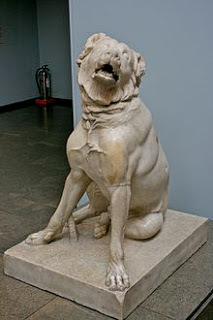 Barry doesn’t exactly have a “speaking” role in this novel, but he is an important character nevertheless.
Barry doesn’t exactly have a “speaking” role in this novel, but he is an important character nevertheless. As explained in the novel, John had not been allowed a dog when a boy because he has spent most of his youth a refugee, living in cramped, urban housing rather than growing up in his father’s castle. As a squire, he is at last allowed to have a dog. Barry therefore symbolizes his new-found independence from his parents, particularly his mother.
Significantly, Barry is a stray. John adopts him not for his beauty or prowess, but for his loyalty. Barry returns the favor by saving John’s life very early in the novel. Thereafter they are inseparable, sharing all adventures in their new life ― to the brink of causing a diplomatic incident.
It is, therefore, the moment when John -- of his own accord -- leaves Barry behind that the reader knows John has grown-up. In this coming-of-age novel that is a significant moment.
Next week's entry, an excerpt from The Last Crusader Kingdom will feature Barry.
 Buy Now!
Buy Now!
Published on January 19, 2018 00:01
January 12, 2018
"A Second Chance" - An Excerpt from "The Last Crusader Kingdom"
A major theme of "Envoy of Jerusalem" was the fate of Christian captives after Hattin or in subsequent defeats. These men and women, who were enslaved by the Saracens, for the most part disappeared into a perpetual hell, but some were restored by ransom payments and the terms of treaties and truces. Even if freed, these men had lost their possessions and families for the most part and they faced a precarious existence in the vulnerable states that clung to the Mediterranean following the Third Crusade. In this episode from "The Last Crusader Kingdom" we follow the fate of one such man.
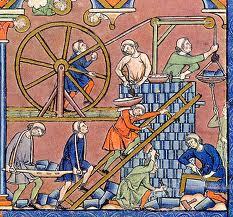
The ringing of vespers marked the end of the twelve-hour day at last, and the men dropped whatever they were doing and lined up for their pay. Ayyub nodded his thanks to the clerk as he took the two dinars, and stashed them inside a purse tied to a cord inside his kaftan. He then hastened around the corner and up the street to a small square with a public fountain....Feeling somewhat restored [by a bath], although sore all over, he started up the street to the Cathedral of the Holy Cross. He had a plan, but it all depended on Master Moses.
On his release after the Treaty of Ramla, Master Moses―like thousands of other former slaves―had washed up in Tyre. In a city overrun with released captives, he was nothing special, just another ex-slave―and a crippled one at that. No one cared what he’d been before Hattin, and a man of forty-something with just one hand could not compete with hordes of healthier, younger men like Ayyub himself. He had ended up a beggar, and it was in this capacity that Ayyub and Moses had met again roughly a year earlier.
Since then Ayyub had made a point of sharing some of his earnings whenever he was lucky. That was rare enough, and Master Moses was visibly failing. He was permanently bent, skeletally thin, and often mentally absent as well. Ayyub was terrified the former master might be too far gone to help him now.
At least he was sitting in his usual spot, nestled into one of the niches formed by the receding arches of the main portal. He had a dirty rag spread out before him for people to drop coins into as they entered or departed. His unkempt mane of graying hair hung about his shoulders, but it had thinned so much that his scabby scalp showed through in many places. His wrinkled face was dirty and blank. He sat with his knees bent before him and his stump propped on them for all to see: a silent plea for alms.
“Master Moses!” Ayyub called as he reached the foot of the stairs up to the portal and started up them.
His former master’s head swung slowly and stared at Ayyub as he approached. He did not smile in pleasure; he just stared.
“Master Moses.” Ayyub went down on his heels in front of the beggar. “What would you say to working as a master builder again? To building aqueducts?”
“I’d say you’ve gone mad,” came the bitter answer.
“But could you do it? Could you design and build an aqueduct? Like we were going to do together?”
“Have you been drinking or chewing khat?” the master builder asked, narrowing his eyes and eying Ayyub suspiciously.
“Neither! I can’t afford such luxuries. The Baron of Ibelin is looking for a master builder to build aqueducts and sewage drains on Cyprus.”
“I’ve seen more sewagedrains than I ever want to see the rest of my life!” the ex-slave growled. “Go away!”
“This isn’t about cleaning them out,” Ayyub protested frantically, his dreams collapsing around his ears. “It’s about designing them and watching other people build them.”
The beggar snorted skeptically and snarled, “What’s in it for you?”
“Just that you take me on as your apprentice, like before: that you take me with you.”
“Where?”
“To Cyprus! Didn’t I already say that? Ibelin wants a master builder willing to go with him to Cyprus.”
“That’s what yousay!” Moses scoffed. “Sounds like a drunkard’s dream to me.”
“I’m not drunk. I’m stone-cold sober, and I heard the exchange myself. What’s the harm in trying?”
“Trying what?”
“Going to find the Baron of Ibelin and presenting yourself.”
Moses ibn Sa’id made a rude noise.
“Come with me!” Ayyub insisted, reaching out to pull Moses to his feet by his forearm.
Moses tried to shake him off, but Ayyub was stronger. “You’re coming with me,” Ayyub insisted.
 Buy Now!
Buy Now!

The ringing of vespers marked the end of the twelve-hour day at last, and the men dropped whatever they were doing and lined up for their pay. Ayyub nodded his thanks to the clerk as he took the two dinars, and stashed them inside a purse tied to a cord inside his kaftan. He then hastened around the corner and up the street to a small square with a public fountain....Feeling somewhat restored [by a bath], although sore all over, he started up the street to the Cathedral of the Holy Cross. He had a plan, but it all depended on Master Moses.
On his release after the Treaty of Ramla, Master Moses―like thousands of other former slaves―had washed up in Tyre. In a city overrun with released captives, he was nothing special, just another ex-slave―and a crippled one at that. No one cared what he’d been before Hattin, and a man of forty-something with just one hand could not compete with hordes of healthier, younger men like Ayyub himself. He had ended up a beggar, and it was in this capacity that Ayyub and Moses had met again roughly a year earlier.
Since then Ayyub had made a point of sharing some of his earnings whenever he was lucky. That was rare enough, and Master Moses was visibly failing. He was permanently bent, skeletally thin, and often mentally absent as well. Ayyub was terrified the former master might be too far gone to help him now.
At least he was sitting in his usual spot, nestled into one of the niches formed by the receding arches of the main portal. He had a dirty rag spread out before him for people to drop coins into as they entered or departed. His unkempt mane of graying hair hung about his shoulders, but it had thinned so much that his scabby scalp showed through in many places. His wrinkled face was dirty and blank. He sat with his knees bent before him and his stump propped on them for all to see: a silent plea for alms.
“Master Moses!” Ayyub called as he reached the foot of the stairs up to the portal and started up them.
His former master’s head swung slowly and stared at Ayyub as he approached. He did not smile in pleasure; he just stared.
“Master Moses.” Ayyub went down on his heels in front of the beggar. “What would you say to working as a master builder again? To building aqueducts?”
“I’d say you’ve gone mad,” came the bitter answer.
“But could you do it? Could you design and build an aqueduct? Like we were going to do together?”
“Have you been drinking or chewing khat?” the master builder asked, narrowing his eyes and eying Ayyub suspiciously.
“Neither! I can’t afford such luxuries. The Baron of Ibelin is looking for a master builder to build aqueducts and sewage drains on Cyprus.”
“I’ve seen more sewagedrains than I ever want to see the rest of my life!” the ex-slave growled. “Go away!”
“This isn’t about cleaning them out,” Ayyub protested frantically, his dreams collapsing around his ears. “It’s about designing them and watching other people build them.”
The beggar snorted skeptically and snarled, “What’s in it for you?”
“Just that you take me on as your apprentice, like before: that you take me with you.”
“Where?”
“To Cyprus! Didn’t I already say that? Ibelin wants a master builder willing to go with him to Cyprus.”
“That’s what yousay!” Moses scoffed. “Sounds like a drunkard’s dream to me.”
“I’m not drunk. I’m stone-cold sober, and I heard the exchange myself. What’s the harm in trying?”
“Trying what?”
“Going to find the Baron of Ibelin and presenting yourself.”
Moses ibn Sa’id made a rude noise.
“Come with me!” Ayyub insisted, reaching out to pull Moses to his feet by his forearm.
Moses tried to shake him off, but Ayyub was stronger. “You’re coming with me,” Ayyub insisted.
 Buy Now!
Buy Now!
Published on January 12, 2018 01:00
January 4, 2018
Characters in The Last Crusader Kingdom: Ayyub/Antonis
The second to the last fictional character from the Last Crusader Kingdom that I'd like to introduce is Ayyub the mason.
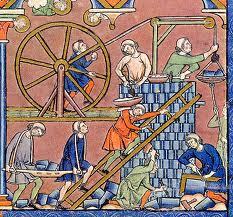
Ayyub enters the novel late and has only a cameo role, but he is vitally important nevertheless. Although I take issue with the conventional thesis that Cyprus was re-populated by during Guy de Lusignan’s short reign and without opposition, the fact that many former inhabitants of the Kingdom of Jerusalem found a new start on Cyprus is indisputable. Significantly, the settlers were not all noblemen -- nor all Latin Christians.
The famous passage attributed to Ernoul describing the settlement of Cyprus includes the following revealing passage:
The knights, sergeants and burgesses whom the Muslims had dispossessed…set off and came to [Cyprus]…[The king] gave rich fiefs, both to the Greeks and the knights he had brought with him and to shoemakers, masons and Arabic scribes….”
As I have said earlier, the account of the settling of Cyprus is highly romanticized and severely abbreviated. That it should include such explicit mention of such humble professions as shoemakers and masons ― not to mention Arabic scribes, who were hardly needed on Cyprus ― is extremely significant. Ernoul (or whoever wrote this account) clearly wanted to highlight the fact that the dispossessed of allclasses and all communities emigrated to Cyprus. It is particularly significant that he underlines the fact that Greeks and the Arabic-speakers also took advantage of the new opportunities on Cyprus.
My character Ayyub is, like Lakis, a double representative. On the one hand, he is a man of common birth, a tradesman not a knight or nobleman, yet no less impoverished by Saladin's victories. Obviously, not all of the dispossessed of the lower classes had been slaves. Some were simply driven from their homes by the advancing armies of Saladin. Yet, tens of thousands of working-class Christian men had gone into Saracen slavery. With Ayyub, I wanted to connect back to Envoy of Jerusalem and remind readers of the fate of the Christians who had fallen into Saracen hands in the course of the collapse of the Kingdom of Jerusalem.
On the other hand, Ayyub is a representative of the non-Latin communities in the crusader states. Far too many novels set in this period completely ignore the bulk of the population: the Orthodox Christians of the Holy Land. Making Ayyub a Melkite Christian was a means of reminding the reader of the large Melkite populations in the crusader states.
By making Ayyub an Arabic speaker, I not only link directly to the text above (that stresses the emigration of Arabic-speakers to Cyprus), but remind readers that the many native Christians had adopted Arabic names and spoke Arabic. It was this use of Arab names and language that has long confused historians into believing that a larger portion of the population of the crusader states had converted to Islam. Yet to this day there are tens of thousands of Christians living in Syria and Lebanon, whose names sound Arabic to us and who’s language is Arabic, yet whose religion is Christian.
But Ayyub is also Antonis because the Arab-speaking, Orthodox immigrants to Cyprus evidently did not retain their Arabic names or language for long. Sharing the same religious rites as the native Greek population to a greater extent than the Latin elites, they integrated more rapidly, married local girls and soon adopted Greek.
Last but not least, by making Ayyub/Antonis a mason, I could emphasize the extent to which Cyprus needed to be rebuilt. The roughly three-hundred years of Frankish rule on Cyprus were a period of extensive and expensive building. Cathedrals, castles, monasteries and palaces were built across the island. Although earthquakes and the Turks have managed to destroy most of what was built in this period, the fragments remaining are monuments to the quality, ingenuity and artistic capabilities of the engineers, masons, sculptors and glass-makers of the last crusader kingdom.
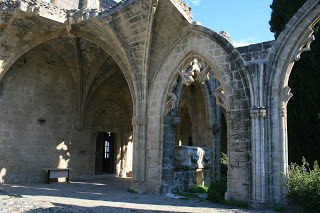
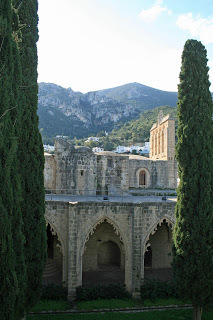
Ruins of the Frankish Cloister of Bellapais near Kyrenia, Cyprus
 Buy Now!
Buy Now!

Ayyub enters the novel late and has only a cameo role, but he is vitally important nevertheless. Although I take issue with the conventional thesis that Cyprus was re-populated by during Guy de Lusignan’s short reign and without opposition, the fact that many former inhabitants of the Kingdom of Jerusalem found a new start on Cyprus is indisputable. Significantly, the settlers were not all noblemen -- nor all Latin Christians.
The famous passage attributed to Ernoul describing the settlement of Cyprus includes the following revealing passage:
The knights, sergeants and burgesses whom the Muslims had dispossessed…set off and came to [Cyprus]…[The king] gave rich fiefs, both to the Greeks and the knights he had brought with him and to shoemakers, masons and Arabic scribes….”
As I have said earlier, the account of the settling of Cyprus is highly romanticized and severely abbreviated. That it should include such explicit mention of such humble professions as shoemakers and masons ― not to mention Arabic scribes, who were hardly needed on Cyprus ― is extremely significant. Ernoul (or whoever wrote this account) clearly wanted to highlight the fact that the dispossessed of allclasses and all communities emigrated to Cyprus. It is particularly significant that he underlines the fact that Greeks and the Arabic-speakers also took advantage of the new opportunities on Cyprus.
My character Ayyub is, like Lakis, a double representative. On the one hand, he is a man of common birth, a tradesman not a knight or nobleman, yet no less impoverished by Saladin's victories. Obviously, not all of the dispossessed of the lower classes had been slaves. Some were simply driven from their homes by the advancing armies of Saladin. Yet, tens of thousands of working-class Christian men had gone into Saracen slavery. With Ayyub, I wanted to connect back to Envoy of Jerusalem and remind readers of the fate of the Christians who had fallen into Saracen hands in the course of the collapse of the Kingdom of Jerusalem.
On the other hand, Ayyub is a representative of the non-Latin communities in the crusader states. Far too many novels set in this period completely ignore the bulk of the population: the Orthodox Christians of the Holy Land. Making Ayyub a Melkite Christian was a means of reminding the reader of the large Melkite populations in the crusader states.
By making Ayyub an Arabic speaker, I not only link directly to the text above (that stresses the emigration of Arabic-speakers to Cyprus), but remind readers that the many native Christians had adopted Arabic names and spoke Arabic. It was this use of Arab names and language that has long confused historians into believing that a larger portion of the population of the crusader states had converted to Islam. Yet to this day there are tens of thousands of Christians living in Syria and Lebanon, whose names sound Arabic to us and who’s language is Arabic, yet whose religion is Christian.
But Ayyub is also Antonis because the Arab-speaking, Orthodox immigrants to Cyprus evidently did not retain their Arabic names or language for long. Sharing the same religious rites as the native Greek population to a greater extent than the Latin elites, they integrated more rapidly, married local girls and soon adopted Greek.
Last but not least, by making Ayyub/Antonis a mason, I could emphasize the extent to which Cyprus needed to be rebuilt. The roughly three-hundred years of Frankish rule on Cyprus were a period of extensive and expensive building. Cathedrals, castles, monasteries and palaces were built across the island. Although earthquakes and the Turks have managed to destroy most of what was built in this period, the fragments remaining are monuments to the quality, ingenuity and artistic capabilities of the engineers, masons, sculptors and glass-makers of the last crusader kingdom.


Ruins of the Frankish Cloister of Bellapais near Kyrenia, Cyprus
 Buy Now!
Buy Now!
Published on January 04, 2018 20:08
December 30, 2017
The Templars and the Holy Grail
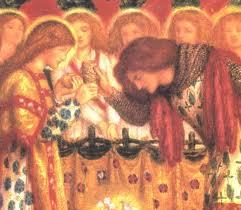
The “Holy Grail” makes its first appearance in literature in the 12th century in a work by Chrétien de Troyes, Perceval. Here, Perceval was a knight of the legendary King Arthur’s Round Table on a quest to find the "Holy Grail." The story was subsequently told and re-told, embellished and altered by various writers, including both Wolfram von Eschenbach and Sir Thomas Malory. In later versions of the Grail quest, Sir Galahad replaced Sir Perceval as the principal hero, but the theme remained popular and was increasingly depicted in works of art as well literature.
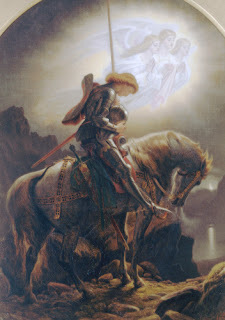
People in the Middle Ages understood that, like King Arthur and the Knights of the Round Table themselves, the Holy Grail was a symbol, a spiritual gift. It was not until the 19th century that people -- increasingly lacking spirituality and thinking of themselves as more “rational” and “scientific” -- crudely turned the Holy Grail into a mere thing. Just people in the 19th and 20thcenturies insisted on trying to identify the “real King Arthur,” modern scholars and enthusiasts have tied themselves in knots trying to explain just what the Holy Grail was ― even inventing the idea that it was the blood of Christ in the form of genetic descendants of Christ and Mary Magdalen.
Another 20th/21stCentury invention is that the Templars were in search of the Holy Grail when they excavated under the Temple of Solomon in Jerusalem. Indeed, it has even been argued that the Templars went all the way to Ethiopia in the 12thcentury in search of the Holy Grail (now transformed into the Ark of the Covenant). Most recently, the History Chanel’s “Knightfall” builds on the notion that there was a connection between the Templars and the Holy Grail.
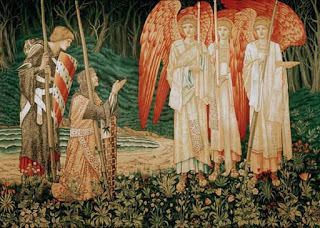 This connection is as spurious and ridiculous as the idea that there wasa Holy Grail in the first place. There can be no evidence of a connection between the Knights Templar and the Holy Grail, because people in the Middle Ages, least of all the practical and hard-headed Knights Templar, weren’t gullible enough to actually think that the Holy Grail was a thing. Since the Templars (at least in theory) disdained secular literature and courtly love, the venue in which the legends and tales of the Holy Grail played out, would have been particularly disdained by the Templars. They probably would not have deigned to admit they knew of the tales at all.
This connection is as spurious and ridiculous as the idea that there wasa Holy Grail in the first place. There can be no evidence of a connection between the Knights Templar and the Holy Grail, because people in the Middle Ages, least of all the practical and hard-headed Knights Templar, weren’t gullible enough to actually think that the Holy Grail was a thing. Since the Templars (at least in theory) disdained secular literature and courtly love, the venue in which the legends and tales of the Holy Grail played out, would have been particularly disdained by the Templars. They probably would not have deigned to admit they knew of the tales at all. 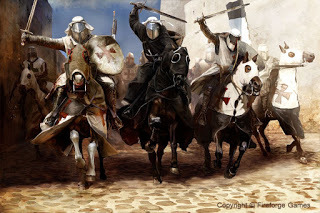 Copyright Fireforge GamesLiterature, whether disguised as pseudo scholarship or, more honestly, fiction, that depicts a relationship between the Knights Templar and an object called the “Holy Grail” belong in the realm of fantasy and should be recognized and treated as such.
Copyright Fireforge GamesLiterature, whether disguised as pseudo scholarship or, more honestly, fiction, that depicts a relationship between the Knights Templar and an object called the “Holy Grail” belong in the realm of fantasy and should be recognized and treated as such. For readers tired of clichés and cartoons, award-winning novelist Helena P. Schrader offers nuanced insight to historical events and figures based on sound research and an understanding of human nature. Her complex and engaging characters bring history back to life as a means to better understand ourselves. Her Jerusalem Trilogy has won 15 literary accolades including Best Biography 2017 (Book Excellence Awards) and Best Christian Historical Fiction 2017 (Readers' Favorites).



Buy now! Buy now! Buy now!
A Templar disaster set the stage for:
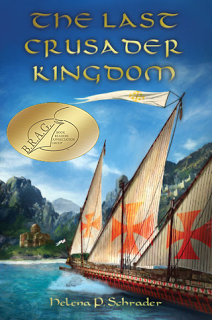 Buy Now!
Buy Now!
Published on December 30, 2017 01:35
December 22, 2017
The Church of the Nativity in Bethlehem
Tomorrow at midnight,
Christians around the world
remember the birth of Christ in the city of Bethlehem.
Today I would like to provide a short history of the Church commemorating that event
The Church of the Nativity in Bethlehem
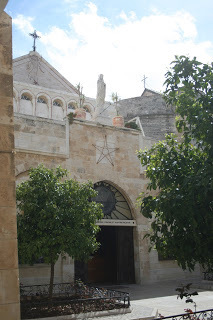 Church of the Nativity, BethlehemAccording to Christian traditions, 2,017 years ago Joseph of Nazareth and his pregnant wife Maria went to Bethlehem, the birthplace of Joseph, in order to comply with a Roman edict to register for a census. They found the city of Bethlehem full to overflowing, and were unable to find a room in either in an inn or the home of Joseph’s relatives. In consequence, they lodged in the cave behind the residence of Joseph’s family in which, as was common at the time, livestock and stores were kept. (To this day, this is a custom in the region.) Here Mary gave birth to a son, Jesus.
Church of the Nativity, BethlehemAccording to Christian traditions, 2,017 years ago Joseph of Nazareth and his pregnant wife Maria went to Bethlehem, the birthplace of Joseph, in order to comply with a Roman edict to register for a census. They found the city of Bethlehem full to overflowing, and were unable to find a room in either in an inn or the home of Joseph’s relatives. In consequence, they lodged in the cave behind the residence of Joseph’s family in which, as was common at the time, livestock and stores were kept. (To this day, this is a custom in the region.) Here Mary gave birth to a son, Jesus.

At the time of his birth Jesus was not of particular importance, hence his birthplace was not in any way noted, marked or honored. It was only after he had died that some of his followers sought to locate the place where he had been born. Since this occurred within the living memory of many of his friends and family, it is not improbable that the house in which Joseph and Mary had stayed--and the stables attached to it--could be accurately identified.
Following the Jewish uprising of 132-135, Hadrian ordered Roman temples erected on top of all Jewish and Christian holy sites. Over the cave in Bethlehem, revered by the small but significant Christian community still resident in Palestine, a temple to Adonis was built. Although certainly an insult to Christians at the time, it was a fortuitous development for later generations since it effectively marked a location that might otherwise have been lost from memory.
In 312, Constantine became Roman Emperor and raised his mother Helena to the rank of Empress. Helena had converted to Christianity and within a year of coming to power, Constantine issued an edict that ended the persecution of Christians. Thereafter and throughout his reign, Constantine was to protect and serve as a patron of the Christian church, without, however, fully suppressing pagan rites.
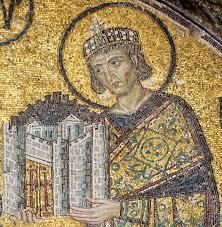 Emperor Constantine - Wall Mosaic in Hagia Sophia, Istanbul (Constantinople)Helena, however, had been an early convert to Christianity and after her son’s rise to ultimate power, she traveled to Palestine in search of the sites of Christ’s passion. According to Christian traditions, she located the site of the crucifixion, excavated the cross on which Christ had been crucified, and also found the tomb in which Christ had been buried. While her son commissioned the construction of a church over the Holy Grave (the Church of the Holy Sepulcher in Jerusalem), Helena is credited with commissioning the construction of a church on the site of Christ’s birth to replace the temple to Adonis.
Emperor Constantine - Wall Mosaic in Hagia Sophia, Istanbul (Constantinople)Helena, however, had been an early convert to Christianity and after her son’s rise to ultimate power, she traveled to Palestine in search of the sites of Christ’s passion. According to Christian traditions, she located the site of the crucifixion, excavated the cross on which Christ had been crucified, and also found the tomb in which Christ had been buried. While her son commissioned the construction of a church over the Holy Grave (the Church of the Holy Sepulcher in Jerusalem), Helena is credited with commissioning the construction of a church on the site of Christ’s birth to replace the temple to Adonis.
Helena’s church was a five-aisled basilica, the mosaics of which are still visible to this day. However, in 529, this church was destroyed in a revolt by the Samaritans.
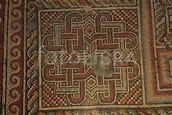
In 540, Emperor Justinian I sponsored the construction of a new basilica over the foundations of the old that stood over and incorporated the cave in which Christ had been born. When Palestine was overrun by the Persians in 614, they destroyed all the churches and monasteries, including Constantine’s church over the Holy Sepulcher — except the Church of the Nativity in Bethlehem. This was because over the portal of the church was a mosaic depicting the adoration of the magi or Three Wise Men in which the magi were wearing “oriental” robes. Based on their dress, Persians invaders recognized the figures in the mosaic as Persian priests; out of respect for their own priests they spared the church. It is this church that can still be found in Bethlehem today, although the mosaic that saved it from destruction has itself since been lost.
In 640, Bethlehem fell to the forces of the Muslim Caliph Omar. Omar, rather than destroying the Church of the Nativity, used it as a place of prayer. Thereafter, parts of the church complex were reserved for Muslim worship. This preserved the church from destruction by less tolerant Muslim leaders such as Caliph el-Hakim, who demolished the Church of the Holy Sepulcher a second time.
When the Crusaders reached Palestine in 1099, they took possession of Bethlehem before launching the assault on Jerusalem. In contrast to the seizure of Jerusalem that ended with a blood-bath, there is no mention of violence or massacre in Bethlehem, probably because the town was neither walled nor defended. It has also been suggested in some sources that the population of Bethlehem was still predominantly Christian when the crusaders arrived.
With the establishment of the Christian Kingdom of Jerusalem, Bethlehem became the seat of a bishop. It remained part of the royal domain, however, and Baldwin of Bouillon was crowned the first King of Jerusalem in the Church of the Nativity. A tradition followed by his successor, Baldwin II, but not subsequent kings, who preferred to be crowned in the Church of the Holy Sepulcher.
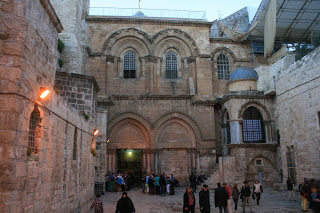 Church of the Holy Sepulcher, JerusalemThe Church of the Nativity became the second most important pilgrimage destination in the Christian world after the Holy Sepulcher itself. As Christian pilgrims flooded to the Holy Land, the city of Bethlehem enjoyed an economic boom. This was supplemented by massive investments on the part of the crusader kings to restore a church that was in a state of significant disrepair when the crusaders arrived. Especially under King Baldwin III and King Amalric I, both of whom were married to Byzantine princesses (Theodora and Maria Comnena respectively), the restoration work was carried out by artists with very high levels of sophistication and influenced by Byzantine traditions. The most extensive mosaics from the crusader period are found in the Church of the Nativity, where no less than 28 frescos dating from the crusader period have been identified. Furthermore, under Christian rule, religious orders were re-established in the Holy Land and a beautiful Romanesque cloister was built adjacent to the Church of the Nativity which can still be visited today.
Church of the Holy Sepulcher, JerusalemThe Church of the Nativity became the second most important pilgrimage destination in the Christian world after the Holy Sepulcher itself. As Christian pilgrims flooded to the Holy Land, the city of Bethlehem enjoyed an economic boom. This was supplemented by massive investments on the part of the crusader kings to restore a church that was in a state of significant disrepair when the crusaders arrived. Especially under King Baldwin III and King Amalric I, both of whom were married to Byzantine princesses (Theodora and Maria Comnena respectively), the restoration work was carried out by artists with very high levels of sophistication and influenced by Byzantine traditions. The most extensive mosaics from the crusader period are found in the Church of the Nativity, where no less than 28 frescos dating from the crusader period have been identified. Furthermore, under Christian rule, religious orders were re-established in the Holy Land and a beautiful Romanesque cloister was built adjacent to the Church of the Nativity which can still be visited today.
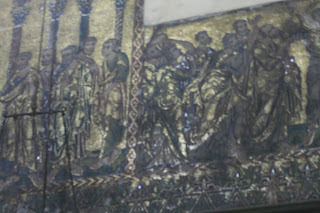 Crusader Mosaics at the Church of the Nativity, Bethlehem
Crusader Mosaics at the Church of the Nativity, Bethlehem
All that ended with the devastating defeat of the Christian army at Hattin on July 4, 1187. Bethlehem had no defenses and no defenders. It fell without a fight to the army of Saladin, and, except for a brief interval from 1229 to 1244, it remained in Muslim hands until it came under the British Protectorate in 1920. Under the various Muslim leaders, Bethlehem became impoverished again. In 1516, the town had only 100 inhabitants! Meanwhile, the church fell increasing into disrepair. The marble wall panels were ripped out to be used in new buildings. In 1646 the tin roof was torn off and melted down for other purposes. The Church would almost certainly have become a complete ruin had not the Greek Orthodox church set out to restore the church with the tolerance of the Ottoman rulers starting in 1670.
Unfortunately, the 18th and 19th centuries saw a bitter fight between the Greek Orthodox, the Roman Catholic and the Armenian churches for control of the Church of the Nativity. In addition, earthquakes, fires and uprisings damaged both the church and the town of Bethlehem. In 1920 Bethlehem came under British administration, and in 1948 fell to Jordan. In 1963, the city numbered roughly 60,000 mostly Christian inhabitants, but the number fell dramatically after Israeli occupation. Today, Bethlehem suffers visibly from the political situation and the tensions between Palestinians and Israelis.
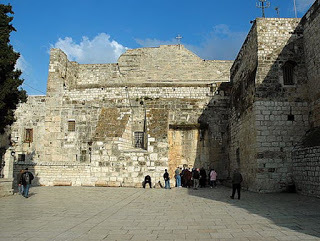 The Fortress-like Construction seems sadly appropriate. Palestinian Terrorists held nuns, priests and tourists hostage here in April 2002.Nevertheless it is still worth a visit today. To be sure, the mosaic mural depicting the adoration of the magi that saved the Church from Persian destruction has been lost, but St. Helena’s floor mosaics can still be seen, as can the mosaic murals of the crusader kings and the crusader-period cloisters. Most important, of course, beneath the high alter in the crypt of the church is the cave in which according to two thousand years of Christian tradition Christ was born over 2000 years ago today.
The Fortress-like Construction seems sadly appropriate. Palestinian Terrorists held nuns, priests and tourists hostage here in April 2002.Nevertheless it is still worth a visit today. To be sure, the mosaic mural depicting the adoration of the magi that saved the Church from Persian destruction has been lost, but St. Helena’s floor mosaics can still be seen, as can the mosaic murals of the crusader kings and the crusader-period cloisters. Most important, of course, beneath the high alter in the crypt of the church is the cave in which according to two thousand years of Christian tradition Christ was born over 2000 years ago today.
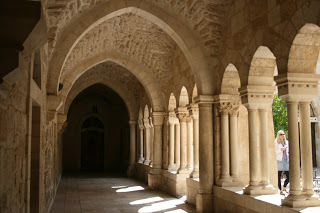 The Crusader cloisters -- my favorite place.
The Crusader cloisters -- my favorite place.
Bethlehem features in my novels set in the Holy Land. It was the scene of a skirmish leading up to the siege of Jerusalem in 1187, which is described in detail in award-winning:
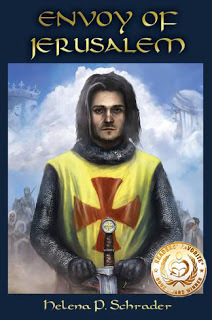 BUY NOW!
BUY NOW!
Christians around the world
remember the birth of Christ in the city of Bethlehem.
Today I would like to provide a short history of the Church commemorating that event
The Church of the Nativity in Bethlehem
 Church of the Nativity, BethlehemAccording to Christian traditions, 2,017 years ago Joseph of Nazareth and his pregnant wife Maria went to Bethlehem, the birthplace of Joseph, in order to comply with a Roman edict to register for a census. They found the city of Bethlehem full to overflowing, and were unable to find a room in either in an inn or the home of Joseph’s relatives. In consequence, they lodged in the cave behind the residence of Joseph’s family in which, as was common at the time, livestock and stores were kept. (To this day, this is a custom in the region.) Here Mary gave birth to a son, Jesus.
Church of the Nativity, BethlehemAccording to Christian traditions, 2,017 years ago Joseph of Nazareth and his pregnant wife Maria went to Bethlehem, the birthplace of Joseph, in order to comply with a Roman edict to register for a census. They found the city of Bethlehem full to overflowing, and were unable to find a room in either in an inn or the home of Joseph’s relatives. In consequence, they lodged in the cave behind the residence of Joseph’s family in which, as was common at the time, livestock and stores were kept. (To this day, this is a custom in the region.) Here Mary gave birth to a son, Jesus. 
At the time of his birth Jesus was not of particular importance, hence his birthplace was not in any way noted, marked or honored. It was only after he had died that some of his followers sought to locate the place where he had been born. Since this occurred within the living memory of many of his friends and family, it is not improbable that the house in which Joseph and Mary had stayed--and the stables attached to it--could be accurately identified.
Following the Jewish uprising of 132-135, Hadrian ordered Roman temples erected on top of all Jewish and Christian holy sites. Over the cave in Bethlehem, revered by the small but significant Christian community still resident in Palestine, a temple to Adonis was built. Although certainly an insult to Christians at the time, it was a fortuitous development for later generations since it effectively marked a location that might otherwise have been lost from memory.
In 312, Constantine became Roman Emperor and raised his mother Helena to the rank of Empress. Helena had converted to Christianity and within a year of coming to power, Constantine issued an edict that ended the persecution of Christians. Thereafter and throughout his reign, Constantine was to protect and serve as a patron of the Christian church, without, however, fully suppressing pagan rites.
 Emperor Constantine - Wall Mosaic in Hagia Sophia, Istanbul (Constantinople)Helena, however, had been an early convert to Christianity and after her son’s rise to ultimate power, she traveled to Palestine in search of the sites of Christ’s passion. According to Christian traditions, she located the site of the crucifixion, excavated the cross on which Christ had been crucified, and also found the tomb in which Christ had been buried. While her son commissioned the construction of a church over the Holy Grave (the Church of the Holy Sepulcher in Jerusalem), Helena is credited with commissioning the construction of a church on the site of Christ’s birth to replace the temple to Adonis.
Emperor Constantine - Wall Mosaic in Hagia Sophia, Istanbul (Constantinople)Helena, however, had been an early convert to Christianity and after her son’s rise to ultimate power, she traveled to Palestine in search of the sites of Christ’s passion. According to Christian traditions, she located the site of the crucifixion, excavated the cross on which Christ had been crucified, and also found the tomb in which Christ had been buried. While her son commissioned the construction of a church over the Holy Grave (the Church of the Holy Sepulcher in Jerusalem), Helena is credited with commissioning the construction of a church on the site of Christ’s birth to replace the temple to Adonis. Helena’s church was a five-aisled basilica, the mosaics of which are still visible to this day. However, in 529, this church was destroyed in a revolt by the Samaritans.

In 540, Emperor Justinian I sponsored the construction of a new basilica over the foundations of the old that stood over and incorporated the cave in which Christ had been born. When Palestine was overrun by the Persians in 614, they destroyed all the churches and monasteries, including Constantine’s church over the Holy Sepulcher — except the Church of the Nativity in Bethlehem. This was because over the portal of the church was a mosaic depicting the adoration of the magi or Three Wise Men in which the magi were wearing “oriental” robes. Based on their dress, Persians invaders recognized the figures in the mosaic as Persian priests; out of respect for their own priests they spared the church. It is this church that can still be found in Bethlehem today, although the mosaic that saved it from destruction has itself since been lost.
In 640, Bethlehem fell to the forces of the Muslim Caliph Omar. Omar, rather than destroying the Church of the Nativity, used it as a place of prayer. Thereafter, parts of the church complex were reserved for Muslim worship. This preserved the church from destruction by less tolerant Muslim leaders such as Caliph el-Hakim, who demolished the Church of the Holy Sepulcher a second time.
When the Crusaders reached Palestine in 1099, they took possession of Bethlehem before launching the assault on Jerusalem. In contrast to the seizure of Jerusalem that ended with a blood-bath, there is no mention of violence or massacre in Bethlehem, probably because the town was neither walled nor defended. It has also been suggested in some sources that the population of Bethlehem was still predominantly Christian when the crusaders arrived.
With the establishment of the Christian Kingdom of Jerusalem, Bethlehem became the seat of a bishop. It remained part of the royal domain, however, and Baldwin of Bouillon was crowned the first King of Jerusalem in the Church of the Nativity. A tradition followed by his successor, Baldwin II, but not subsequent kings, who preferred to be crowned in the Church of the Holy Sepulcher.
 Church of the Holy Sepulcher, JerusalemThe Church of the Nativity became the second most important pilgrimage destination in the Christian world after the Holy Sepulcher itself. As Christian pilgrims flooded to the Holy Land, the city of Bethlehem enjoyed an economic boom. This was supplemented by massive investments on the part of the crusader kings to restore a church that was in a state of significant disrepair when the crusaders arrived. Especially under King Baldwin III and King Amalric I, both of whom were married to Byzantine princesses (Theodora and Maria Comnena respectively), the restoration work was carried out by artists with very high levels of sophistication and influenced by Byzantine traditions. The most extensive mosaics from the crusader period are found in the Church of the Nativity, where no less than 28 frescos dating from the crusader period have been identified. Furthermore, under Christian rule, religious orders were re-established in the Holy Land and a beautiful Romanesque cloister was built adjacent to the Church of the Nativity which can still be visited today.
Church of the Holy Sepulcher, JerusalemThe Church of the Nativity became the second most important pilgrimage destination in the Christian world after the Holy Sepulcher itself. As Christian pilgrims flooded to the Holy Land, the city of Bethlehem enjoyed an economic boom. This was supplemented by massive investments on the part of the crusader kings to restore a church that was in a state of significant disrepair when the crusaders arrived. Especially under King Baldwin III and King Amalric I, both of whom were married to Byzantine princesses (Theodora and Maria Comnena respectively), the restoration work was carried out by artists with very high levels of sophistication and influenced by Byzantine traditions. The most extensive mosaics from the crusader period are found in the Church of the Nativity, where no less than 28 frescos dating from the crusader period have been identified. Furthermore, under Christian rule, religious orders were re-established in the Holy Land and a beautiful Romanesque cloister was built adjacent to the Church of the Nativity which can still be visited today.  Crusader Mosaics at the Church of the Nativity, Bethlehem
Crusader Mosaics at the Church of the Nativity, Bethlehem All that ended with the devastating defeat of the Christian army at Hattin on July 4, 1187. Bethlehem had no defenses and no defenders. It fell without a fight to the army of Saladin, and, except for a brief interval from 1229 to 1244, it remained in Muslim hands until it came under the British Protectorate in 1920. Under the various Muslim leaders, Bethlehem became impoverished again. In 1516, the town had only 100 inhabitants! Meanwhile, the church fell increasing into disrepair. The marble wall panels were ripped out to be used in new buildings. In 1646 the tin roof was torn off and melted down for other purposes. The Church would almost certainly have become a complete ruin had not the Greek Orthodox church set out to restore the church with the tolerance of the Ottoman rulers starting in 1670.
Unfortunately, the 18th and 19th centuries saw a bitter fight between the Greek Orthodox, the Roman Catholic and the Armenian churches for control of the Church of the Nativity. In addition, earthquakes, fires and uprisings damaged both the church and the town of Bethlehem. In 1920 Bethlehem came under British administration, and in 1948 fell to Jordan. In 1963, the city numbered roughly 60,000 mostly Christian inhabitants, but the number fell dramatically after Israeli occupation. Today, Bethlehem suffers visibly from the political situation and the tensions between Palestinians and Israelis.
 The Fortress-like Construction seems sadly appropriate. Palestinian Terrorists held nuns, priests and tourists hostage here in April 2002.Nevertheless it is still worth a visit today. To be sure, the mosaic mural depicting the adoration of the magi that saved the Church from Persian destruction has been lost, but St. Helena’s floor mosaics can still be seen, as can the mosaic murals of the crusader kings and the crusader-period cloisters. Most important, of course, beneath the high alter in the crypt of the church is the cave in which according to two thousand years of Christian tradition Christ was born over 2000 years ago today.
The Fortress-like Construction seems sadly appropriate. Palestinian Terrorists held nuns, priests and tourists hostage here in April 2002.Nevertheless it is still worth a visit today. To be sure, the mosaic mural depicting the adoration of the magi that saved the Church from Persian destruction has been lost, but St. Helena’s floor mosaics can still be seen, as can the mosaic murals of the crusader kings and the crusader-period cloisters. Most important, of course, beneath the high alter in the crypt of the church is the cave in which according to two thousand years of Christian tradition Christ was born over 2000 years ago today. The Crusader cloisters -- my favorite place.
The Crusader cloisters -- my favorite place.Bethlehem features in my novels set in the Holy Land. It was the scene of a skirmish leading up to the siege of Jerusalem in 1187, which is described in detail in award-winning:
 BUY NOW!
BUY NOW!
Published on December 22, 2017 22:46
December 16, 2017
Of Archbishops and Crusaders -- An Excerpt from "The Last Crusader Kingdom"
The power of the Church in 12th Century Europe was not confined to the spiritual realm. On the contrary, because of their aristocratic background, high levels of education, and lack of dynastic ambitions, princes of the church were widely employed as royal officers. As chancellors, particularly, bishops and archbishops often wielded great influence in secular affairs. In this excerpt from The Last Crusader Kingdom based on a true incident during the "German Crusade of 1197," John d'Ibelin must convince an Archbishop, the Archbishop of Hildesheim and Chancellor of the Holy Roman Empire, to take military action.
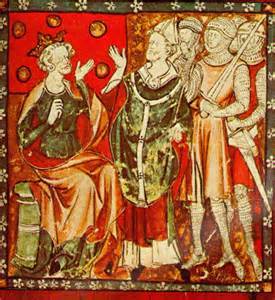
[John d'Ibelin] burst into the Archbishop's great hall to find it already crowded with men milling about. To his relief, the Archbishops of Acre and Hildesheim sat together on the dais. They were apparently in earnest discussion with a number of noblemen. John pushed his way through the seething crowds in the lower hall, unable to understand what was agitating the occupants, because they were all speaking German. He sprang onto the dais, provoking a tardy response from a young knight in Hildesheim's service. The latter tried to put himself between John and the men at the table, but John shoved him aside so forcefully that two German noblemen sprang to their feet with their hands on their hilts.
"My lord of Hildesheim!" John called out to the Imperial Chancellor from half a dozen feet away. "Your men are plundering and looting in the streets of Acre as if they were in Damascus! And you have nothing better to do than sit and drink?" The outrage in John's voice rang to the vaulted ceiling and reverberated there.
The German noblemen at once drew their swords and shouted back at John, while behind him a general uproar erupted. The Archbishop of Acre, however, leaned back in his chair with an odd smile on his face, and the Imperial Chancellor gestured for silence, telling the noblemen to sheath their swords.
The level of noise dropped but did not fully die away. The Imperial Chancellor spoke into the lull, "It's young John d'Ibelin, is it not?" He spoke in Latin.
"Yes, my lord," John answered in the same tongue, because it was their only common language.
"And you presume to give orders to me? The Imperial Chancellor of the Holy Roman Empire?" he asked with raised eyebrows.
"My sister the queen," John started deliberately. He was breathing heavily, but he had a grip on himself. He answered slowly and clearly, speaking so every man in the hall could hear him, "...is in grief and mourning. The Dowager Queen of Jerusalem, therefore, tasked me with restoring order. And that I will do, even if it means riding down and butchering your men," John bluffed. "I would prefer, however, if you brought your men to order."
Behind him he heard men muttering "Juden" and "Schweine," but he ignored them and focused on the Imperial Chancellor. Hildesheim might be a bishop, but he was a worldly bishop -- and one who know how to wield a mace.
"What makes you so certain you can stop thousands of fighting men from obtaining what they believe is their just reward, young man?"
"My faith in God, my lord bishop," John answered as forcefully as he could, gulping air into his lungs to try to calm his racing pulse. "He knows that what your men do is an offense against His people -- the people he was born to -- and His Holy Gospel, for which He gave His sacred blood. Even now my men are calling out the watch. If you do not take action, we will." John's heart was pounding furiously in his breast. God help me! He pleaded silently. God help me!
"Is this not what I have been saying for the last hour?" the Archbishop of Acre spoke up, leaning forward and hissing to his fellow bishop: "You know it is the right thing to do."
"My men won a great victory over the Saracens, and what have they got for it? Nothing. No loot. No gold. Nothing."
"They have received the remission of sins past," the Archbishop of Acre countered, "but not, I must stress, absolution for what they are doing now. The sins they are committing here in the Holy Land against innocent people will take them all to hell, regardless of what they did to al-Adil's army!"
Hildesheim looked over at Acre with raised eyebrows for a moment, but then he pulled his feet under him and stood. He started distributing orders in German. The noblemen around him nodded, turned toward the hall, and started calling to their men. Abruptly all the men in the hall appeared to scrambling to find their helmets and gauntlets. John felt himself quaking. If they were going to join their men in the looting, he -- no, Acre -- was utterly lost.
As if reading his mind, Hildesheim clapped him on the shoulder and remarked, "You win, boy. I've ordered my knights to rein in their men and move them out of Acre. We'll set up camp outside the walls -- and then look for a Saracen city to sack."
 Buy Now!
Buy Now!

[John d'Ibelin] burst into the Archbishop's great hall to find it already crowded with men milling about. To his relief, the Archbishops of Acre and Hildesheim sat together on the dais. They were apparently in earnest discussion with a number of noblemen. John pushed his way through the seething crowds in the lower hall, unable to understand what was agitating the occupants, because they were all speaking German. He sprang onto the dais, provoking a tardy response from a young knight in Hildesheim's service. The latter tried to put himself between John and the men at the table, but John shoved him aside so forcefully that two German noblemen sprang to their feet with their hands on their hilts.
"My lord of Hildesheim!" John called out to the Imperial Chancellor from half a dozen feet away. "Your men are plundering and looting in the streets of Acre as if they were in Damascus! And you have nothing better to do than sit and drink?" The outrage in John's voice rang to the vaulted ceiling and reverberated there.
The German noblemen at once drew their swords and shouted back at John, while behind him a general uproar erupted. The Archbishop of Acre, however, leaned back in his chair with an odd smile on his face, and the Imperial Chancellor gestured for silence, telling the noblemen to sheath their swords.
The level of noise dropped but did not fully die away. The Imperial Chancellor spoke into the lull, "It's young John d'Ibelin, is it not?" He spoke in Latin.
"Yes, my lord," John answered in the same tongue, because it was their only common language.
"And you presume to give orders to me? The Imperial Chancellor of the Holy Roman Empire?" he asked with raised eyebrows.
"My sister the queen," John started deliberately. He was breathing heavily, but he had a grip on himself. He answered slowly and clearly, speaking so every man in the hall could hear him, "...is in grief and mourning. The Dowager Queen of Jerusalem, therefore, tasked me with restoring order. And that I will do, even if it means riding down and butchering your men," John bluffed. "I would prefer, however, if you brought your men to order."
Behind him he heard men muttering "Juden" and "Schweine," but he ignored them and focused on the Imperial Chancellor. Hildesheim might be a bishop, but he was a worldly bishop -- and one who know how to wield a mace.
"What makes you so certain you can stop thousands of fighting men from obtaining what they believe is their just reward, young man?"
"My faith in God, my lord bishop," John answered as forcefully as he could, gulping air into his lungs to try to calm his racing pulse. "He knows that what your men do is an offense against His people -- the people he was born to -- and His Holy Gospel, for which He gave His sacred blood. Even now my men are calling out the watch. If you do not take action, we will." John's heart was pounding furiously in his breast. God help me! He pleaded silently. God help me!
"Is this not what I have been saying for the last hour?" the Archbishop of Acre spoke up, leaning forward and hissing to his fellow bishop: "You know it is the right thing to do."
"My men won a great victory over the Saracens, and what have they got for it? Nothing. No loot. No gold. Nothing."
"They have received the remission of sins past," the Archbishop of Acre countered, "but not, I must stress, absolution for what they are doing now. The sins they are committing here in the Holy Land against innocent people will take them all to hell, regardless of what they did to al-Adil's army!"
Hildesheim looked over at Acre with raised eyebrows for a moment, but then he pulled his feet under him and stood. He started distributing orders in German. The noblemen around him nodded, turned toward the hall, and started calling to their men. Abruptly all the men in the hall appeared to scrambling to find their helmets and gauntlets. John felt himself quaking. If they were going to join their men in the looting, he -- no, Acre -- was utterly lost.
As if reading his mind, Hildesheim clapped him on the shoulder and remarked, "You win, boy. I've ordered my knights to rein in their men and move them out of Acre. We'll set up camp outside the walls -- and then look for a Saracen city to sack."
 Buy Now!
Buy Now!
Published on December 16, 2017 00:21
December 9, 2017
Bellapais - Inspirational Settings
Aimery de Lusignan established a Latin church hierarchy on Cyprus and throughout their 300-year rule the Lusignans were generous patrons of the Latin Church. One of the most magnificent and inspiring remnants of that symbiotic relationship are the ruins of the "Abbey of Beautiful Peace" -- the Abbaye de la Belle Paix or Bellapais. Below is a short history and some photos.
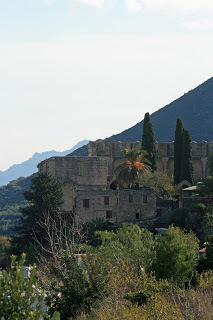 The Abbey of Bellapais is located on the shoulder of a mountain just six miles (10 km) east of the port of Kyrenia. Although no archaeological evidence has been found, based on earlier designations of the location historians presume an Orthodox church or bishop's residence once sat on this site, which has natural springs.
The Abbey of Bellapais is located on the shoulder of a mountain just six miles (10 km) east of the port of Kyrenia. Although no archaeological evidence has been found, based on earlier designations of the location historians presume an Orthodox church or bishop's residence once sat on this site, which has natural springs.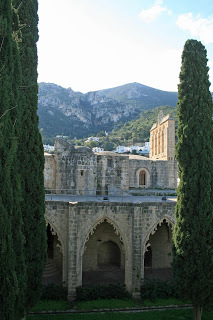
Augustinian monks from the Holy Sepulcher, fleeing the Kingdom of Jerusalem after the disaster at Hattin, were the first to found a monastery on the location of the Abbey of Bellapais. The construction of this first abbey commenced almost immediately after a papal bull of December 1196 formally inaugurated a Latin diocesan establishment on Cyprus. Aimery de Lusignan was personally the abbey's patron, and construction of the first monastery is dated from 1198-1205. Unfortunately, little of this original building have survived to the present, although the under croft of the refectory likely dates from this period.
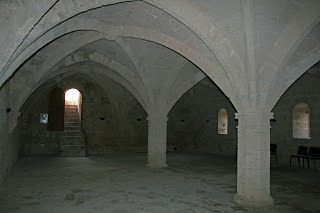
Shortly after Aimery's death, the abbey requested permission to follow the Premonstratensian rule, a stricter form of the Augustinian order, and were granted permission by the Archbishop of Nicosia. Because of the white habits of the Premonstratensian canons, the Abbey was also known colloquially as the White Abbey. (Although the white stone against the green vegetation would be another explanation of the name....)
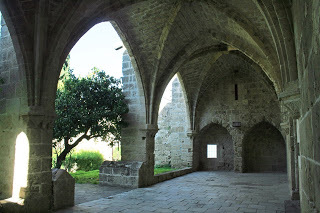
Royal patronage of the abbey continued under Aimery's successors. The Abbots of Bellais were even granted the right to wear golden spurs and a sword when outside the abbey grounds, rights usually reserved for knights. More important, however, royal patronage probably financed, directly or indirectly, a massive building programs undertaken over the next two centuries.
In the reign of Hugh III (1267 - 1284), the church was built.
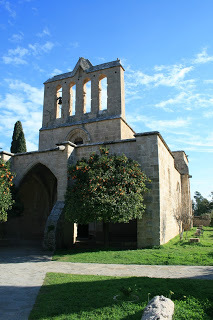
But the more impressive architecture dates from a more massive re-building program during the first half of the next century. This is when the cloisters were "modernized," and the chapter house, dormitory, and refectory that we see today were built.
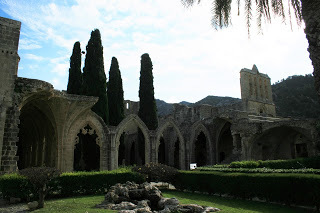
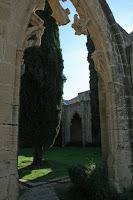
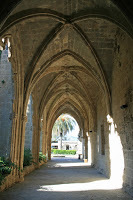
The cloisters of Bellapais Abbey
By the 16th century, however, the Abbey was already in decay -- not just physically but morally as well. By then the Lusignan dynasty had fallen and been replaced by Venetian administration. Responding to complaints, the Venetian state investigated conditions at the abbey and reported that not only were the buildings so neglected that they were in a ruinous state but that the canons had abandoned their vows of chastity and lived with women -- allegedly in at least one case with no less than three women.
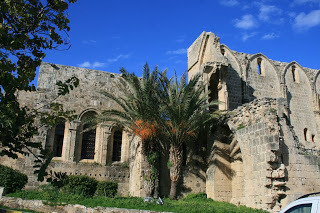 Venetian plans to expel the corrupt "white monks" and replace them with Franciscans were over taken by events. In 1570 the island fell to the Turks and the monks were driven from the island. Although the church was probably converted into an Orthodox church, the other buildings of the abbey were used as a quarry for the construction or as stalls and barns for livestock.
Venetian plans to expel the corrupt "white monks" and replace them with Franciscans were over taken by events. In 1570 the island fell to the Turks and the monks were driven from the island. Although the church was probably converted into an Orthodox church, the other buildings of the abbey were used as a quarry for the construction or as stalls and barns for livestock. 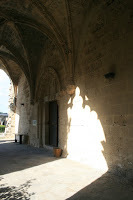
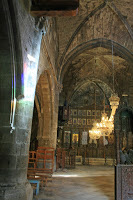 Only after the British assumed administration of the island in 1878 did the decay stop. The refectory was temporarily used as a military hospital and later as a school. In the early 20th century, the process of preserving and respecting the original buildings finally began.
Only after the British assumed administration of the island in 1878 did the decay stop. The refectory was temporarily used as a military hospital and later as a school. In the early 20th century, the process of preserving and respecting the original buildings finally began. Today Bellapais is a museum.
The Last Crusader Kingdom was Cyprus. Follow me to Cyprus as the Lusignans established their rule there with the help of the Ibelins.
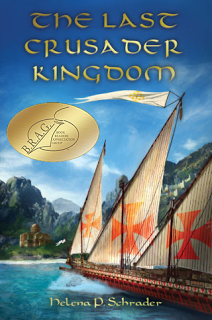 BUY NOW!
BUY NOW!
Published on December 09, 2017 06:06
December 2, 2017
"Rebels Against the Hospital" - An Excerpt from "The Last Crusasder Kingdom"
My thesis in "The Last Crusader Kingdom" is that the Lusignans initially faced armed resistance from the local Greek population of Cyprus. Based on my experiences as a diplomat, I know that insurrections and unrest often target the economic infrastructure, particularly installations that are seen to be benefiting the regime.
In this episode from "The Last Crusader Kingdom" a sugar factory operated by the Knights Hospitaller has been burned down and John d'Ibelin has been sent by Aimery de Lusignan to question the local inhabitants. He has entered the church of a nearby village.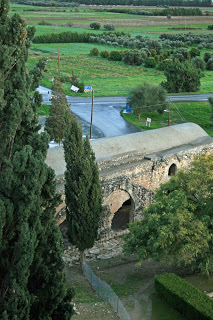 The 13th century sugar mill at Kolossi built on the ruins of an earlier sugar factory.[John's] eyes had adjusted enough to see the two Orthodox priests -- or rather, a priest and a monk -- staring at him warily from the railing before the dark, dilapidated screens. He approached them and addressed them respectfully in his best Greek: "Good sirs, forgive me for interrupting, but I was hoping you could help me." The looks of astonishment on their faces to have a young Frank address them in fluent Greek pleased John.
The 13th century sugar mill at Kolossi built on the ruins of an earlier sugar factory.[John's] eyes had adjusted enough to see the two Orthodox priests -- or rather, a priest and a monk -- staring at him warily from the railing before the dark, dilapidated screens. He approached them and addressed them respectfully in his best Greek: "Good sirs, forgive me for interrupting, but I was hoping you could help me." The looks of astonishment on their faces to have a young Frank address them in fluent Greek pleased John.
Their surprise also gave him a moment to study them. The priest had wavy grey hair and a soft, fluffy beard of the same color, but his face was not really old -- no older, John guessed, than his father. It was marked by lines made more by smiling than frowning. The monk, on the other hand, was younger, with dark hair and beard, and his face was lined by anger. It also reminded John of someone, but he couldn't quite remember who.
It was the monk who replied hotly, "What do you Franks need help with? Killing, burning, and raping?"
The priest immediately put his hand on the younger man's arm and shook his head. "Curb your tongue, Brother," he told his companion before addressing John to ask, "What might we be able to help you with?"
"The hospital at Kolossi was attacked last Friday by a large mob. They plundered the entire complex, even the church," John stressed, "and they stole from the patients as well. The priεst was stripped naked and tied backwards on a mule and then chased away." As he related this incident John watched the faces of the two men opposite him. The monk frowned, while the priest raised his eyebrows and looked over at the younger man a if asking for verification.
"He was not harmed -- unlike many of our priests, monks, and nuns!" the monk defended the outrage. "Indeed, no one was raped or killed."
"You seem to know a great deal about what happened," John observed. "Can you tell me more about who was involved in the attack and why? Why attack a hospital caring for the poor? Why destroy a factory that brought work and income to these poor communities?"
"The land was stolen from us! It is our land! Our country! You are not welcome here!"
"Would it be better for people to have neither medical care nor jobs?" John asked with the simplicity of youth.
"You understand nothing! Just like the rest of your stupid, brutal, barbarian people," the monk dismissed him angrily.
"You say he understands nothing, yet he asks good questions," the priest spoke up in a calm, firm voice. "It is what my parishioners have been asking me all week," he added. "They had little enough as it was. Now they have nothing. They do not know how they are going to feed themselves, and they are terrified of retribution. Up to now, all the trouble has been in the north and east; now they fear the Franks will come and take revenge on us here for this."
"The Franks need to be shown they are neither wanted nor invincible! They have to learn they have no place here, and that we can fight them! You," the monk turned on John, "you are not wanted here! Go back where you came from!"
"I can't," John answered, his beardless chin raised in proud defiance. "Salah ad-Din took it away." He pronounced Saladin's name as he had learned it, in Arabic.
"Well go fight him for it, then! Just because you were beaten by the Saracens doesn't give you the right to steal from us!" the monk snarled back, raising his voice in anger.
 Buy Now!
Buy Now!
In this episode from "The Last Crusader Kingdom" a sugar factory operated by the Knights Hospitaller has been burned down and John d'Ibelin has been sent by Aimery de Lusignan to question the local inhabitants. He has entered the church of a nearby village.
 The 13th century sugar mill at Kolossi built on the ruins of an earlier sugar factory.[John's] eyes had adjusted enough to see the two Orthodox priests -- or rather, a priest and a monk -- staring at him warily from the railing before the dark, dilapidated screens. He approached them and addressed them respectfully in his best Greek: "Good sirs, forgive me for interrupting, but I was hoping you could help me." The looks of astonishment on their faces to have a young Frank address them in fluent Greek pleased John.
The 13th century sugar mill at Kolossi built on the ruins of an earlier sugar factory.[John's] eyes had adjusted enough to see the two Orthodox priests -- or rather, a priest and a monk -- staring at him warily from the railing before the dark, dilapidated screens. He approached them and addressed them respectfully in his best Greek: "Good sirs, forgive me for interrupting, but I was hoping you could help me." The looks of astonishment on their faces to have a young Frank address them in fluent Greek pleased John.Their surprise also gave him a moment to study them. The priest had wavy grey hair and a soft, fluffy beard of the same color, but his face was not really old -- no older, John guessed, than his father. It was marked by lines made more by smiling than frowning. The monk, on the other hand, was younger, with dark hair and beard, and his face was lined by anger. It also reminded John of someone, but he couldn't quite remember who.
It was the monk who replied hotly, "What do you Franks need help with? Killing, burning, and raping?"
The priest immediately put his hand on the younger man's arm and shook his head. "Curb your tongue, Brother," he told his companion before addressing John to ask, "What might we be able to help you with?"
"The hospital at Kolossi was attacked last Friday by a large mob. They plundered the entire complex, even the church," John stressed, "and they stole from the patients as well. The priεst was stripped naked and tied backwards on a mule and then chased away." As he related this incident John watched the faces of the two men opposite him. The monk frowned, while the priest raised his eyebrows and looked over at the younger man a if asking for verification.
"He was not harmed -- unlike many of our priests, monks, and nuns!" the monk defended the outrage. "Indeed, no one was raped or killed."
"You seem to know a great deal about what happened," John observed. "Can you tell me more about who was involved in the attack and why? Why attack a hospital caring for the poor? Why destroy a factory that brought work and income to these poor communities?"
"The land was stolen from us! It is our land! Our country! You are not welcome here!"
"Would it be better for people to have neither medical care nor jobs?" John asked with the simplicity of youth.
"You understand nothing! Just like the rest of your stupid, brutal, barbarian people," the monk dismissed him angrily.
"You say he understands nothing, yet he asks good questions," the priest spoke up in a calm, firm voice. "It is what my parishioners have been asking me all week," he added. "They had little enough as it was. Now they have nothing. They do not know how they are going to feed themselves, and they are terrified of retribution. Up to now, all the trouble has been in the north and east; now they fear the Franks will come and take revenge on us here for this."
"The Franks need to be shown they are neither wanted nor invincible! They have to learn they have no place here, and that we can fight them! You," the monk turned on John, "you are not wanted here! Go back where you came from!"
"I can't," John answered, his beardless chin raised in proud defiance. "Salah ad-Din took it away." He pronounced Saladin's name as he had learned it, in Arabic.
"Well go fight him for it, then! Just because you were beaten by the Saracens doesn't give you the right to steal from us!" the monk snarled back, raising his voice in anger.
 Buy Now!
Buy Now!
Published on December 02, 2017 01:13



